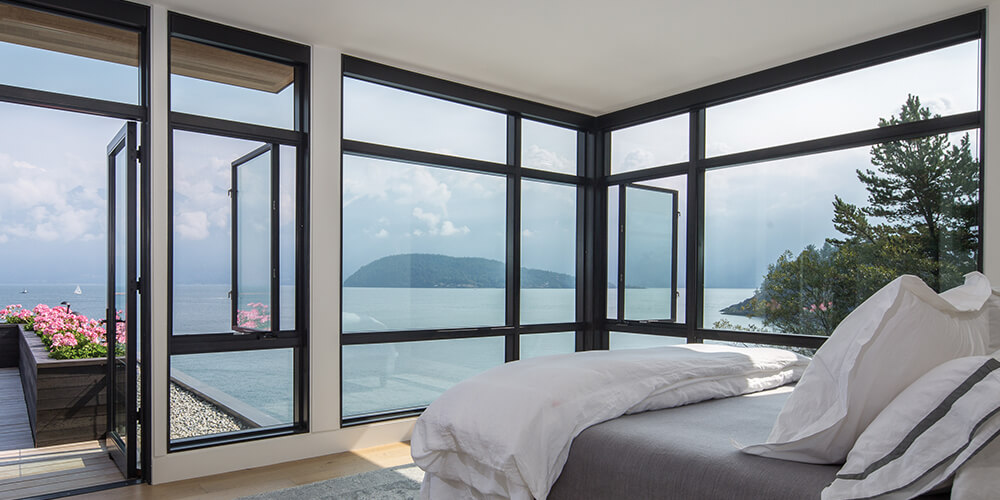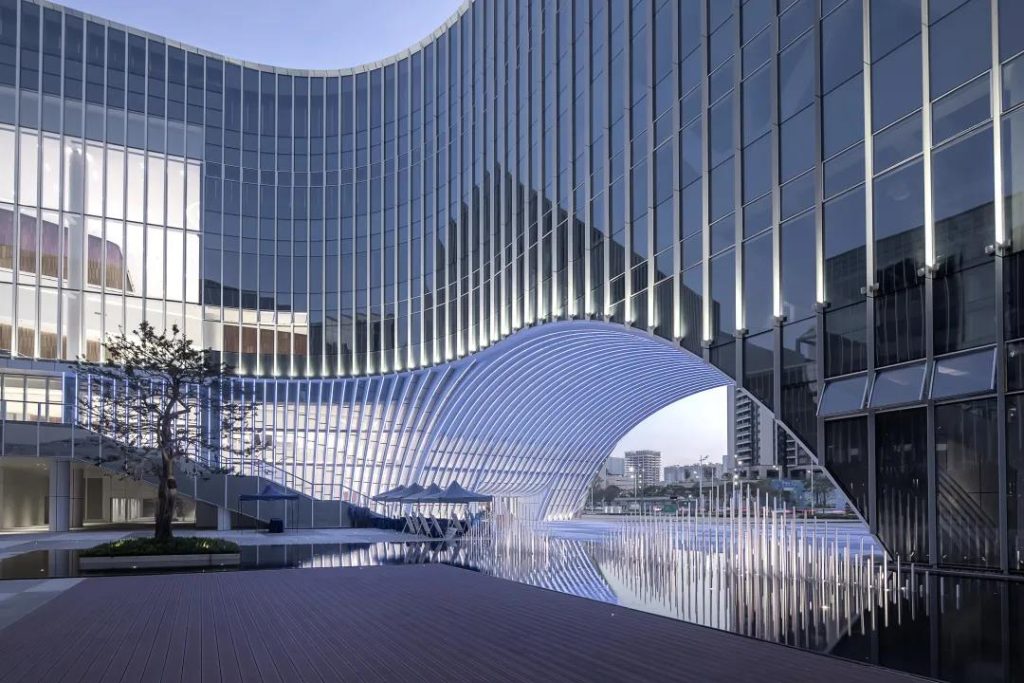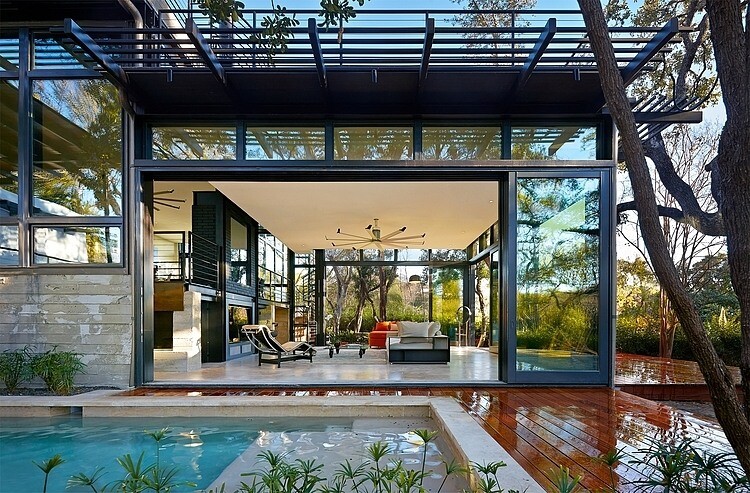When designing a building, choosing between window walls and curtain walls is crucial. Though they might seem similar, they serve different purposes and can affect your building’s aesthetics, energy efficiency, and structural integrity.
Not sure which one is right for your project? We’ll break down the differences, helping you decide which system best meets your needs for cost, insulation, and design. Let’s explore what sets them apart and why it matters.
What Is the Curtain Wall?
A curtain wall acts as an exterior “skin” for a building, often consisting of materials like glass, aluminum, or steel. It is non-load bearing, meaning it doesn’t support the structure of the building but rather provides protection from the elements.
Curtain walls can be either stick-built or panelized. In stick-built systems, the components are assembled on-site. For panelized curtain walls, prefabricated units are shipped ready to be anchored directly to the building slabs. Typically, curtain walls have a depth ranging between six and 10 inches.
One important consideration with curtain walls is the fire-stopping between floors to prevent the spread of fire. Noise transmittance can also be an issue, especially in high-traffic areas. Additionally, curtain walls tend to be more expensive compared to traditional window systems.

What Is the Wall Window?
Wall windows are installed between floor slabs and are typically anchored at both the top and bottom of the wall. They span from floor to floor and are non-load bearing, offering a sleek, uninterrupted view of the exterior.
Wall windows are pre-fabricated and designed for easy installation. Because they sit between floor slabs, there’s no need for additional fire-stopping measures. Noise transmittance is also less of an issue, making wall windows a practical and stylish solution for many building designs.
If you’re aiming for a smooth and continuous exterior appearance, you can opt for a slab bypass cover, which provides a seamless transition between the floors, enhancing the building’s visual appeal.

How Does the Cost Compare Between Curtain Walls and Window Walls?
When choosing between curtain walls and window walls, cost is a major consideration. While both systems offer unique advantages, the price difference can play a big role in your decision-making process. Below is a detailed comparison of the costs associated with both systems:
| Criterion | Curtain Walls | Window Walls |
|---|---|---|
| Initial Installation Cost | Higher due to custom design, premium materials, and complex installation | Lower, as prefabricated units simplify installation and reduce labor |
| Material Costs | Premium materials like aluminum, steel, and high-performance glass | Less expensive materials and standard prefabricated panels |
| Labor Costs | Skilled labor required for structural integration and sealing | Quicker installation with less specialized labor |
| Maintenance Costs | Higher, due to frequent seal replacements and cleaning of large glass areas | Lower, simpler repairs and fewer specialized maintenance needs |
| Long-Term Value | High, thanks to superior insulation, durability, and aesthetic appeal | Moderate, cost-effective but with potential higher energy and repair expenses |
What Are the Structural Benefits of Curtain Walls and Window Walls?
Both curtain walls and window walls offer significant benefits in terms of structural integrity and performance. However, their applications and benefits vary depending on the project’s needs.

1. Structural Support
Curtain Walls: These are non-load-bearing and are attached to the building’s frame, providing additional wind resistance and protection from external elements without contributing to the building’s overall load. They’re designed to withstand large forces like wind pressure, especially in high-rise buildings.
Window Walls: Like curtain walls, window walls are also non-load-bearing, but they are typically more integrated into the building structure. They sit between the floor slabs and offer some load-bearing capacity, adding stability to the building’s envelope.
2. Wind and Weather Resistance
Curtain Walls: Built to resist strong wind pressure, curtain walls can be reinforced with insulation, weatherproofing seals, and high-performance glass. This makes them a reliable option for buildings in areas prone to extreme weather conditions, such as hurricanes or heavy storms.
Window Walls: While window walls provide some weather resistance, they tend to be less robust compared to curtain walls in extreme weather conditions. They are more commonly used in mid-rise buildings where wind resistance requirements aren’t as severe.
3. Energy Efficiency
Curtain Walls: Due to the large surface area, curtain walls often incorporate insulated glass and thermal breaks to prevent heat loss and enhance the building’s energy efficiency. This makes them ideal for buildings that need to meet high energy standards.
Window Walls: Energy efficiency varies depending on the type of window used. While they can still be energy-efficient, window walls usually offer fewer options for insulation and weatherproofing compared to curtain walls.
 Common Concerns
Common Concerns
How Do Curtain Walls and Window Walls Affect Energy Efficiency?
Energy efficiency is a crucial consideration in building design. Curtain walls and window walls can both contribute to a building’s energy performance, but they do so in different ways. Below is a comparison of how each system impacts thermal insulation, glazing, solar heat gain, and HVAC performance:
| Criterion | Curtain Walls | Window Walls |
|---|---|---|
| Thermal Insulation | Insulated glass and thermal breaks minimize heat loss | Basic glazing, fewer insulation options |
| Glazing Options | Advanced Low-E coatings and solar control glass | Limited glazing choices, standard glass |
| Solar Heat Gain & Shading | Built-in shading devices reduce heat gain | Minimal shading, higher cooling load |
| HVAC Impact | Lowers HVAC load with better insulation | Increases HVAC demand due to heat gain |
Which Option Provides Better Aesthetic Flexibility for Modern Designs?
When it comes to design, both curtain walls and window walls offer unique benefits, but they cater to different aesthetic needs. Curtain walls are perfect for large commercial buildings projects, offering expansive glass facades that create a sleek, modern look. Their ability to cover entire building facades with minimal structure makes them ideal for a minimalist design with lots of natural light.
On the other hand, window walls provide a softer, more integrated appearance. They are often used in smaller to mid-sized buildings where the goal is a contemporary yet subtle look. While they may not offer the same grandeur as curtain walls, window walls still provide plenty of design flexibility, with options for materials like aluminum and steel, though they’re more limited in customization compared to curtain walls.
Ultimately, curtain walls are the go-to choice for creating bold, high-impact visuals, while window walls are more versatile for smaller projects or designs that call for a more understated look.

What Are the Noise Control Differences Between Curtain Walls and Window Walls?
Noise control is an important factor, especially for buildings located in busy urban areas. When it comes to reducing sound, curtain walls generally offer better performance. Thanks to their thicker glass, insulation, and air gaps, curtain walls are designed to block out more noise, making them ideal for high-rise buildings in noisy environments. The added layers of glass and insulation help keep external sounds at bay, creating a quieter interior.
Window walls, while still offering some level of sound insulation, tend to perform less effectively in terms of noise reduction. Due to their thinner materials and more limited insulation options, window walls may let in more sound, which can be a concern for buildings near high-traffic areas or industrial zones. While they can be equipped with noise-reducing glass, they don’t provide the same level of soundproofing as curtain walls.
Window walls can be made with noise-reducing glass. (True)
Window walls can be fitted with noise-reducing glass, but the overall soundproofing effectiveness is still typically lower compared to curtain walls. The glass type and the overall design will affect how much noise is blocked.
Are Curtain Walls or Window Walls More Cost-Effective in the Long Run?
When it comes to long-term costs, it’s important to weigh not just the initial investment but also the maintenance, durability, and energy savings each system provides. While curtain walls are generally more expensive upfront, they may offer better long-term value depending on the type of building and its usage.
Curtain walls, with their higher installation and material costs, are often seen as an investment in durability and performance. Their superior insulation, energy efficiency, and weather resistance mean they can lower energy bills over time and require fewer repairs in the long run. They are ideal for high-rise buildings or projects where longevity and low maintenance are key priorities.
Window walls, on the other hand, come with a lower initial cost, making them a more budget-friendly option for smaller buildings or those with less demanding requirements. However, due to their relatively lower energy efficiency and potential for higher maintenance needs, they might incur higher long-term costs, particularly in buildings that experience significant wear and tear or need frequent repairs.

What Safety Considerations Should Be Made When Installing Curtain Walls or Window Walls?
Safety is always a top priority in construction, and both curtain walls and window walls come with specific safety considerations. Whether it’s fire resistance, impact resistance, or ensuring compliance with building codes, the right system can help minimize risks.
Curtain walls are typically designed with fire safety in mind. They include fire-rated insulation and are often equipped with fire-resistant seals to prevent the spread of fire between floors. These features make them an ideal choice for high-rise buildings or structures that require high fire protection standards. Additionally, the materials used in curtain walls, like tempered glass, offer better impact resistance, which helps prevent damage from external forces such as wind or debris.
Window walls, while generally safe, may not offer the same level of fire protection as curtain walls. They are often simpler in design and lack the specialized fireproofing features found in curtain walls. However, window walls can still meet safety standards if properly designed and installed, especially for buildings that are not as high or in areas with lower fire risk. Impact resistance is also lower compared to curtain walls, making window walls more susceptible to damage in extreme weather conditions.
Both curtain walls and window walls can be used in buildings of any height. (False)
While curtain walls are suitable for buildings of any height, window walls are typically used in smaller to mid-rise buildings. Window walls may not offer the same wind resistance and structural support required for very tall buildings.
What Safety Considerations Should Be Made When Installing Curtain Walls or Window Walls?
The right choice depends on your building’s needs.
At PA Home, we offer both curtain wall and window wall solutions tailored to meet your specific needs, ensuring that your building performs efficiently while staying within budget.
If you want to equip your commercial or residential mid-rise buildings with top-tier curtain wall and window wall solutions, contact PA Home today for the latest designs.
FAQs
The vertical element separating adjacent window units is called a mullion.
The surrounding support that holds the glass and sash is the window frame.
The movable part that holds the glass is known as the sash.
The inset area where the window sits—between the exterior wall and the glass—is the reveal.
A window wall spans floor to floor and sits between slabs, while a curtain wall hangs from the building frame and covers the entire facade.
Costs vary by material and design but typically range from $50 to $200 per square foot, including installation.
They often offer less thermal insulation, limited customization, and may be more prone to air and water infiltration than curtain walls.
A full-height glass facade is commonly called a glass curtain wall.
The three main systems are stick-built, unitized, and semi-unitized curtain walls.


